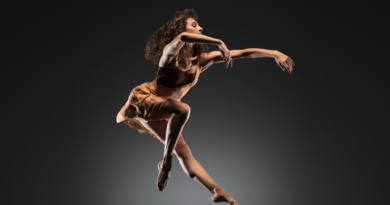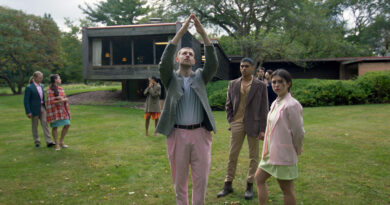Whipped Dream
American Ballet Theatre is back in Chicago with a new work that unveils the sweeter side of its first Artist-in-Residence, Alexander Ratmansky.
By Fred Cummings
First American Ballet Theatre Artist-In-Residence and 2013 MacArthor Foundation Fellow Alexander Ratmansky is known for tackling weighty, sober works on the grandest of scales. His work at the Bolshoi (where he served as artistic director for more than five years) included The Bright Stream (2006), for which he won a Critics’ Circle National Dance Award and The Flames of Paris (2008), set in the Soviet-era. His reconstructions of Marius Petipa’s Paquita in 2014 and The Sleeping Beauty the following year—both set on American Ballet Theatre—stand as near legendary undertakings for modern era ballet. These and many other Ratmansky works fit neatly within the scope of an evening length piece with a sprawling story arc and an emotional gulf you could sink the Titanic in.
Perhaps that’s why his latest work, a fanciful story ballet, came as so much of a surprise to critics when it first premiered in 2017, because it is such a sharp departure from his usual heavy fare. Entitled Whipped Cream, Ratmansky’s newest work is a journey to the Russian choreographer’s softer, perhaps sweeter side.
Set to a long overlooked score by Richard Strauss, Whipped Cream is a whimsical fantasy ballet full of confectionery fun, eye-popping delights, zany sentiment and, above all, simply wonderful dance.
The story is a simple one. After receiving his first communion, a young boy is rewarded with a trip to a pastry shop, where he dives face first into an endless serving of sweets, treats and deserts of every make and model. The problem is by the time he finally comes up for air, he is plummeted into a delirious haze and is quickly dispatched to the hospital. There he’s met with the dark and brooding world of doctors and nurses and the looming shadow that sickness casts for a child (and many adults), all represented by mysterious creatures, ghoulish puppets and imposing instruments of affliction. Suddenly, he is rescued by the beautiful Princess Praline and the kind of sugary delights that put him there in the first place and whisked off to a wondrous land of confectionery bliss—a dream for any child, to be sure.
The dream comes to life in Ratmansky’s choreography, which, though extravagant, is still very deeply rooted in time-honored ballet technique. American Ballet Theatre assistant artistic director Clinton Luckett explains: “Ratmansky choreographed Whipped Cream utilizing the traditional vocabulary of classical ballet, but with a highly stylized execution—especially as expressed through the port de bras and upper body movements of the various characters.”
Luckett adds that this, ornamented by some very specific timings and accents, helps to imbue the choreography with elements of wit not often readily noticed in Ratmansky’s work.
Something Whipped Cream does share with Ratmansky’s catalogue is the fact that its inspiration was drawn from dance history. In this case, Richard Strauss’ first foray into composition for ballet, Schlagobers (Whipped Cream), was a bit of a mess when it first premiered in Vienna in 1924. Critics found the music too overly developed, not “dancerly” enough and rather unfit for the once-regal Vienna State Ballet it was set upon. But Ratmansky is no stranger to breathing new life into long-since dormant works. The ambitious choreographer cut his teeth on re-staging traditional classical ballets for large companies. In 2002, his first three-act story ballet, Cinderella, received critical acclaim when it was premiered by the Kirov Ballet. In 2011, the National Ballet of Canada in Toronto unveiled his choreography for Sergei Prokofiev’s Romeo and Juliet, earning him significant praise from The New York Times’ Alastair Macaulay, who called him “the most gifted choreographer specializing in classical ballet today.”
But the challenge that re-staging Whipped Cream for contemporary audiences presents is interpreting Strauss’ score in a way that is native to the vocabulary of classical ballet while balancing the shift in tone from light and airy to dark and brooding that is so evident in the score. Luckett explains that Ratmansky’s approach is quite in tune with the mercurial shifts in Strauss’ music. “Following the tone in Strauss’ highly colorful score, the Act 1 Sweet Shop Pas d’Action for Princess Tea Flower and her retinue is a scene of lightness and refinement, like a delicate pastry, and is filled with highly refined, lyrically expressive choreography. In contrast, the Act 2 Hospital scenes with the Doctor and his Nurses are full of movements that are angular, aggressive, and full of menace–as the music vividly suggests.”
Creating just the right set design to compliment Ratmansky’s choreography and Strauss’ score was essential to pulling off this restaging, however, and to accomplish that, American Ballet Theatre tapped pop-surrealist artist Mark Ryden to bring the hypnagogic world of Whipped Cream to life. Ryden, a celebrated painter known as the founder of the “pop surrealism” genre, designed more than 150 costumes and lavish, colorful sets for the production. The intricate detail work of his designs incorporated more than 78,000 Swarovsky crystals designs. Ryden’s contributions helped to formalize Ratmansky’s vision for Whipped Cream and the ethos surrounding the dream of confectionery paradise it brings to the stage.
As Luckett explains, his work was pivotal. “The contribution of (Mark) Ryden was paramount to the overall success of the production,” he told me. “His designs for both the scenery and the costumes perfectly realized the fantastical nature of the work, and also the world in which it takes place. As an artist working for the first time in the theater, his embrace of the specific needs and demands of theatrical production design allowed for an extremely fruitful collaboration with Ratmansky and the entire company.”
The success of the Ryden/Ratmansky collaboration is likely one of the reasons for the all-too-easy comparison Whipped Cream bears to another very famous fantasy ballet, The Nutcracker. But Luckett insists the comparison has little merit. “Like The Nutcracker, the story of Whipped Cream is a fantasy and thus, full of fantastical elements,” he insisted. “There is a focus on ‘sweets’ that is shared by the 2nd act of Nutcracker, and each work features some darker plot elements. Despite these general similarities I would say they are very different works and don’t really bear comparison.”
Still, many see the works in the same vein. And because of the monumental appeal of The Nutcracker, the expectation is that Whipped Cream will live up to the wild success the holiday tradition enjoys. But rather than seeing the work as the next generation of The Nutcracker, Whipped Cream should be seen as a rare look at the softer, more whimsical side of the leading creator for new classical ballet. And for that, the work is a must-see.
Chicagoans will get a chance to indulge when American Ballet Theatre returns to Auditorium Theatre this spring to premiere the evening-length ballet to the Windy City. They’ll present the work to Strauss’ scarcely heard score performed live by the Chicago Philharmonic. For Luckett, it’s an opportunity for audiences to peer into that wild imagination of a world class choreographer. “(Ratmansky) is an artist capable of great wit and humor, and Whipped Cream is one of the best examples of those aspects of his talent.” He explained. “It demonstrates, yet again, the incredible range of his choreographic imagination.
You can see American Ballet Theatre in Alexander Ratmansky’s Whipped Cream April 11 – 14, 2019 at Auditorium Theatre of Roosevelt University.




